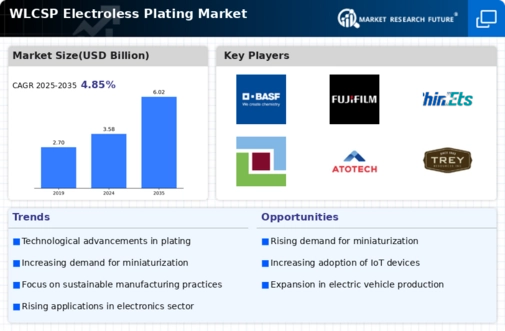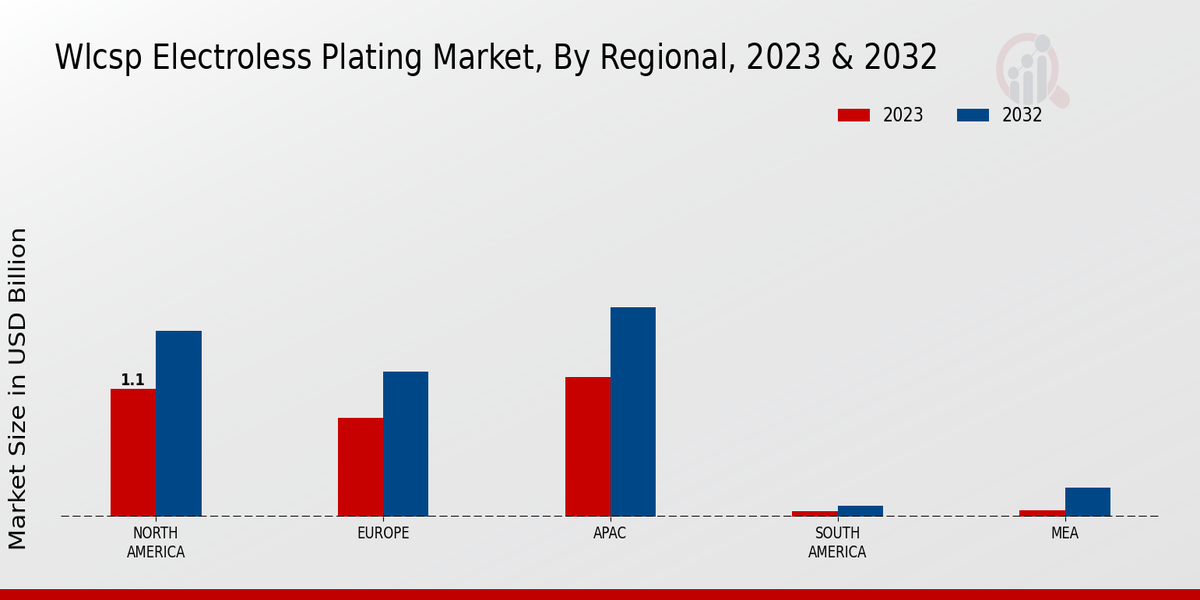Growing Demand for Miniaturization
The Global WLCSP Electroless Plating Market Industry experiences a notable surge in demand driven by the trend towards miniaturization in electronics. As devices become smaller and more compact, manufacturers are increasingly adopting Wafer-Level Chip Scale Packaging (WLCSP) technologies. This shift allows for reduced package size while maintaining performance, which is critical in sectors like consumer electronics and telecommunications. The industry's growth is reflected in projections indicating a market value of 3.58 USD Billion in 2024, with expectations to reach 6.02 USD Billion by 2035, suggesting a robust CAGR of 4.84% from 2025 to 2035.
Market Trends and Growth Projections
The Global WLCSP Electroless Plating Market Industry is characterized by dynamic trends and growth projections. The market is expected to experience a steady increase, with a valuation of 3.58 USD Billion in 2024, anticipated to grow to 6.02 USD Billion by 2035. This growth trajectory suggests a CAGR of 4.84% from 2025 to 2035. Key trends influencing this growth include the rise of electric vehicles, advancements in semiconductor technology, and the increasing need for high-performance electronic components. These factors collectively indicate a robust future for the industry, positioning it as a critical player in the global electronics market.
Emerging Markets and Global Expansion
Emerging markets present a promising opportunity for the Global WLCSP Electroless Plating Market Industry. Countries in Asia-Pacific, Latin America, and Africa are witnessing rapid industrialization and urbanization, leading to increased demand for electronic devices. As local manufacturers seek to enhance their production capabilities, the adoption of advanced packaging technologies, including WLCSP, becomes imperative. This trend is likely to contribute to the overall market growth, with projections indicating a rise from 3.58 USD Billion in 2024 to 6.02 USD Billion by 2035. The anticipated CAGR of 4.84% from 2025 to 2035 highlights the potential for expansion in these regions.
Increasing Adoption of Consumer Electronics
The proliferation of consumer electronics serves as a significant driver for the Global WLCSP Electroless Plating Market Industry. With the continuous introduction of new smartphones, tablets, and wearable devices, manufacturers are compelled to adopt advanced packaging solutions like WLCSP to meet consumer demands for performance and efficiency. This trend is underscored by the projected market growth from 3.58 USD Billion in 2024 to 6.02 USD Billion by 2035, indicating a strong CAGR of 4.84% from 2025 to 2035. The need for high-density interconnections and miniaturized components further propels the demand for electroless plating technologies.
Regulatory Compliance and Quality Standards
Regulatory compliance and adherence to quality standards play a crucial role in shaping the Global WLCSP Electroless Plating Market Industry. As electronic devices become more complex, manufacturers face increasing scrutiny regarding the materials and processes used in production. Compliance with international standards, such as RoHS and REACH, necessitates the adoption of reliable and sustainable plating methods. This regulatory landscape drives the demand for electroless plating solutions that meet stringent quality requirements. Consequently, the industry is expected to grow, with market values projected at 3.58 USD Billion in 2024 and 6.02 USD Billion by 2035, reflecting a CAGR of 4.84% from 2025 to 2035.
Advancements in Electroless Plating Technologies
Technological advancements in electroless plating processes significantly influence the Global WLCSP Electroless Plating Market Industry. Innovations such as improved chemical formulations and enhanced deposition techniques enable better control over plating thickness and uniformity. These advancements not only enhance the reliability of electronic components but also reduce production costs. For instance, the introduction of environmentally friendly plating solutions aligns with global sustainability initiatives, appealing to manufacturers seeking to minimize their ecological footprint. As a result, the industry is poised for growth, with a projected market size of 3.58 USD Billion in 2024, expanding to 6.02 USD Billion by 2035.










